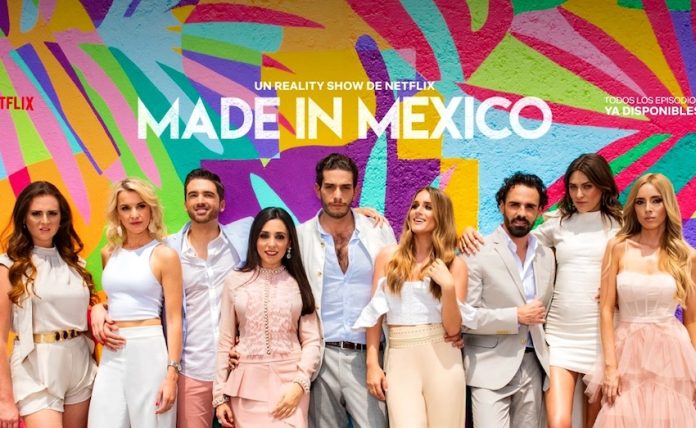There are countless things to love about Mexico.
TV entertainment is not one of them.

In my quest to learn everything possible about my adopted country, I’ve watched many Mexican-made Netflix series. While there are anomalies (“La Casa de las Flores” and “Luis Miguel: la serie,” for example) the majority are so bad I’ve had to turn them off.
One of the worst, in my humble opinion, is the reality show “Made in Mexico.”
The 8-part series follows a group of Mexican socialites navigating life in their early 30s in the country’s capital. As you can imagine, everyone is fashionable, wealthy and good-looking. The show touches on the usual themes — love, friendship, nightlife and the struggles of being a high-class, directionless youth trying to make it on your own in what one character describes as “the Beverly Hills of Mexico City”, aka Polanco.
Before you close out of this article (because I know you want to) allow me to admit a shameful truth.
I learned more about Mexican society from this stupid show than I have actually living here.
View this post on Instagram
This includes the concept of a whitexican, or a privileged, upper-class Mexican which MND writer Gaby Solís has eloquently elaborated on in her article, What is a whitexican? Which is essentially exactly what this show is about. The term doesn’t surface often, if at all, but everything the characters represent embodies its definition. Between their propensity for English idioms, their distinct social class, and the somewhat suffocating role of “keeping up with the Joneses” (the Jones usually being your immediate family), the actual reality of this reality show is quite…real.
A real example of whitexicans doing natural things in their natural habitat.
This class of Mexicans have lighter skin (but not always!), nice clothes, branded purses, and a team of housekeepers in their exquisite and modern apartments. They went to private high schools, dine in the trendiest restaurants, and take exotic vacations.
Maybe you’re thinking “well this isn’t the type of Mexican I hang out with, so I don’t care.” Perhaps. But it is a Mexico that exists and it’s a Mexico that defines so much of what you see, hear, and read about. Understanding the nuances is a step to cultural fluency. You’ve decided to live here, and it’s your responsibility to become as fluent in “Mexico” as you can.
Made in Mexico will prepare you in ways language classes, dating, and daily life cannot. Here’s the valuable information that eight hours invested in this show will arm you with.
Slang
The series opens up with an explanation of a fresa, a term you probably hear on occasion. Each of the protagonists gives their own interpretation, which basically means “entitled”, eventually telling the viewer that everyone on the show is a fresa. How do you spot a fresa? Similar to (but not the same as) a whitexican, fresas have a certain way of speaking (which sounds like they have una papa en la boca, or a potato in their mouth), dressing (preppy and designer everything, men with slicked back hair and women with long, painstakingly curled locks that inhibit their ability to look quickly to one side), and spending their time (at their family’s ranch house, taking selfies for their fashion blog, or promoting their latest philanthropic venture).
In defense of the show’s fresas, most do embody the Mexican spirit of extreme work ethic. All of the Mexican characters (seem to) have multiple professional commitments and full schedules.

Other valuable slang you’ll hear that will make eavesdropping on the table of ladies next to you at brunch so much easier include:
- Bonachón: a nice guy
- Godín: a 9-to-5-er
- Cañón: difficult, cool, depending on the context
- Padre: cool
- Está del nabo: it sucks
Classism
Mexico is classist, there are no two ways around it. The importance of one’s rank on the hierarchical ladder is made clear in Made in Mexico, as it defines many things: your wealth, your connections, your family, and your reputation. The latter is determined by your family history, so if you have a revolutionary, politician, or prominent business owner in your lineage, you are expected to maintain or exceed the level of status previously set.
Religion
Religion plays a huge role in Mexican society, which quickly becomes apparent in Episode 1. One of the main characters is of Lebanese descent (a significant subset of Mexico’s upper and working classes which I hadn’t been fully aware of until I watched the show) and, at 32, is finally moving out of his God-fearing mother’s home. On move-in day, she showers him with crosses, icons, and Virgin Mary statues to be placed in specific areas of his house for protection. To my mind, what he really needs protection from is her, but that leads me to another valuable lesson I learned watching Made in Mexico.
Family
We all know that family plays a major role in Latin culture. But do you really know how much of a role it plays? As mentioned, children (especially sons) inherit the sometimes impossible task of maintaining a family’s reputation by taking over the business or starting one. It also means your marriage choices are limited to those in your social class or above. How often do you see the CEO marrying a maid? While things like this can be commonplace in countries like the U.S. or U.K., it rarely, if ever, happens in Mexico.
Patriotism
One theme that is apparent in the show is something I’ve noticed in my own life here, and it’s something I personally find so wonderful. Mexicans are very proud to be Mexican. Nearly everyone you meet, whether they make street tacos or run a multi-million dollar corporation, loves their heritage. It feels as if the entire population knows their nation’s history, rattling off random facts about Tenochtitlán at the drop of a dime (which we catch a glimpse of in Episode 1). When driving north from the center of Mexico City with friends, I was impressed at their ability to explain the topography, including the names of buildings or mountains and the stories behind them. I spent 6 years living in Philadelphia just blocks from the Liberty Bell and I still can’t tell you why it’s there. Maybe this is the reason that Made in Mexico is brimming with spectacular shots of the capital and its surrounding area.
I will warn you. Watching Made in Mexico requires a thick skin. Still, between multiple moments of cringe, you’ll be learning. Some of the lessons are outright and others will seep into your psyche through osmosis. You won’t realize it until one day, you’re reading a Mexico News Daily article about Carlos Slim and think, hey, isn’t he Lebanese? At that point, you might harken back to the scene where Roby, a Lebanese-Mexican, describes the plight of Lebanese Catholics to Mexico to escape the Ottomans, and something will click. And you’ll thank those eight hours of trashy TV entertainment for taking you one step closer to Mexican fluency.
Want to know more about Whitexicans? Check out the Mexican perspective by Mexican writer Gaby Solís.
Bethany Platanella is a travel planner and lifestyle writer based in Mexico City. She lives for the dopamine hit that comes directly after booking a plane ticket, exploring local markets, practicing yoga and munching on fresh tortillas. Sign up to receive her Sunday Love Letters to your inbox, peruse her blog, or follow her on Instagram.
